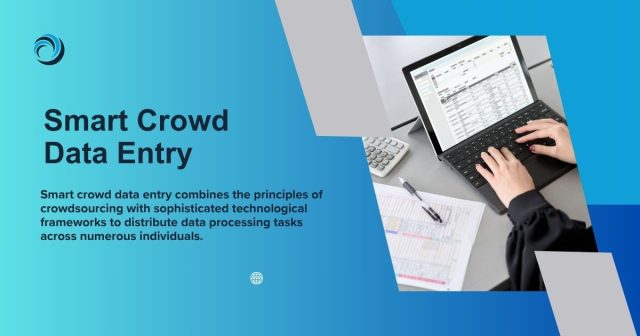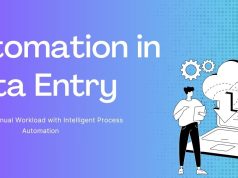In an era where data drives decision-making across industries, the ability to process vast amounts of information quickly and accurately has become a critical competitive advantage. Smart crowd data entry represents a revolutionary approach to handling data processing challenges by leveraging collective intelligence, distributed workforces, and advanced quality control mechanisms. This innovative methodology transforms traditional data entry operations into scalable, flexible, and highly accurate systems.
Understanding Smart Crowd Data Entry
Smart crowd data entry combines the principles of crowdsourcing with sophisticated technological frameworks to distribute data processing tasks across numerous individuals. Unlike traditional outsourcing models, this approach fragments complex data projects into microtasks that can be completed by a distributed workforce, then reassembled through intelligent systems.
The “smart” component refers to the integration of artificial intelligence, machine learning algorithms, and quality control mechanisms that oversee the process, ensuring consistency and accuracy while dramatically improving scalability. This combination of human intelligence and technological oversight creates a powerful synergy that addresses many limitations of conventional data processing methods.
The Evolution of Data Processing Methodologies

Data entry has undergone significant transformation throughout its history. Initially reliant on in-house teams working with physical documents, the industry gradually shifted toward outsourcing models that leveraged labor cost arbitrage across global markets. The emergence of digital transformation initiatives in recent decades accelerated the need for more sophisticated approaches.
The traditional outsourcing model, while cost-effective in certain scenarios, often struggled with scalability challenges, quality inconsistencies, and communication barriers. As data volumes expanded exponentially with the rise of big data, these limitations became increasingly problematic for organizations seeking to maintain competitive advantages through data-driven decision making.
Smart crowd data entry emerged as a response to these challenges, offering a more distributed and flexible framework capable of handling variable data volumes while maintaining high quality standards. By incorporating elements of the gig economy with enterprise-grade quality assurance, this approach creates a hybrid model that combines the best aspects of human judgment with technological efficiency.
Core Components of Smart Crowd Data Entry Systems

Distributed Workforce Management
At the heart of smart crowd data entry lies an extensive network of contributors with diverse skills and availability. These individuals—often ranging from professional data specialists to part-time contributors—form a flexible workforce that can scale up or down based on project requirements. The distributed nature of this workforce provides several advantages:
- Around-the-clock processing capabilities through contributors in different time zones
- Rapid scalability without the overhead costs associated with hiring full-time employees
- Access to specialized skills that might be unavailable or costly in local labor markets
- Redundancy that prevents bottlenecks when individual contributors become unavailable
The management of this distributed workforce relies on sophisticated platforms that handle contributor onboarding, skill assessment, task distribution, and compensation. These systems typically incorporate reputation mechanisms that track individual performance metrics, allowing for continuous refinement of the contributor pool.
Task Fragmentation and Workflow Design
Smart crowd data entry platforms excel at breaking down complex data processing jobs into smaller, manageable units that can be distributed efficiently. This fragmentation serves multiple purposes:
- It allows for parallel processing, dramatically reducing completion times for large projects
- It creates natural verification points where quality can be assessed before proceeding
- It enables specialized handling of different data types within the same overall project
- It facilitates the incorporation of both human and automated processing steps where appropriate
The design of these workflows requires careful consideration of dependencies, sequencing, and quality checkpoints. Modern platforms incorporate visual workflow designers that allow project managers to map out process flows, establish validation rules, and define escalation procedures for exceptions.
You Should Know About Beginner Guide to Data Entry Design
Quality Control and Validation Mechanisms
Perhaps the most sophisticated aspect of smart crowd data entry systems lies in their multi-layered approach to quality assurance. Unlike traditional models that rely heavily on sampling and post-processing verification, smart crowd systems build quality controls into every stage of the process:
- Pre-validation screening: Contributors are matched to tasks based on demonstrated proficiency in similar work
- Redundant processing: Critical data fields may be processed by multiple contributors independently, with discrepancies flagged for review
- Rule-based validation: Automated systems check entries against predefined business rules and known reference data
- Statistical pattern analysis: Machine learning models identify anomalies that might indicate potential errors
- Expert review queues: Exceptions and edge cases are routed to specialized contributors with advanced domain knowledge
These layered approaches create a system of checks and balances that dramatically improves accuracy rates compared to traditional models. Research conducted by MIT’s Center for Collective Intelligence suggests that properly designed crowd data entry systems can achieve accuracy rates exceeding 99.5%, outperforming both dedicated outsourcing teams and fully automated solutions in complex scenarios.
AI Integration: Elevating Smart Crowd Data Entry

The integration of artificial intelligence technologies has significantly enhanced the capabilities of smart crowd data entry systems. Rather than replacing human contributors, AI serves as both an augmentation tool and a quality control mechanism:
Pre-processing Assistance
Modern systems employ computer vision and natural language processing to perform initial data extraction from unstructured sources. For instance, when processing invoices, AI components might:
- Identify relevant fields through document layout analysis
- Extract standard information using optical character recognition
- Pre-populate structured data based on previous patterns
- Flag uncertain elements for human verification
This pre-processing reduces the cognitive load on human contributors, allowing them to focus their attention on validation and correction rather than basic data extraction.
Real-time Guidance and Error Prevention
As contributors work through assignments, AI-powered assistants can provide real-time guidance through:
- Contextual suggestions based on partial entries
- Detection of potential errors before submission
- Reference information relevant to the current field
- Adaptive instructions based on contributor performance patterns
These AI-powered assistants continuously learn from aggregate contributor behaviors, refining their suggestions based on observed patterns and validation outcomes.
Post-processing Enhancement
After human contributors complete their portions of the work, AI systems can further enhance the data through:
- Standardization of formats across entries
- Entity resolution across multiple data sources
- Enrichment with additional reference information
- Confidence scoring to guide downstream usage
According to research by Gartner on augmented intelligence, this collaborative human-machine approach delivers 40% greater productivity than either approach in isolation.
Industry Applications and Success Stories
Smart crowd data entry has found successful applications across numerous industries, each leveraging the methodology’s unique advantages to address specific challenges:
Healthcare Records Management
Healthcare organizations face stringent accuracy requirements combined with variable processing volumes. Smart crowd approaches allow these organizations to process patient records, insurance claims, and clinical documentation while maintaining HIPAA compliance through specialized contributor pools with appropriate certifications.
A major healthcare network implemented a smart crowd system for processing insurance claims and reported a 63% reduction in processing time while improving accuracy by 22% compared to their previous outsourced model. The system’s ability to handle seasonal volume fluctuations without quality degradation proved particularly valuable during open enrollment periods.
You can read this blog https How to Automate Data Entry from Excel to Website
Financial Document Processing

Financial institutions process millions of documents daily, from loan applications to compliance filings. The sensitivity of financial information requires exceptional accuracy while competitive pressures demand rapid turnaround times.
A global banking institution deployed a smart crowd solution for mortgage application processing, achieving 99.8% accuracy while reducing processing time from an average of 27 hours to just 4 hours. The system’s ability to route complex cases to specialists while handling routine elements through standard channels created significant efficiency gains.
Research and Academic Publishing
Academic publishers and research institutions manage enormous volumes of specialized content requiring domain expertise. Smart crowd approaches allow these organizations to tap into networks of subject matter experts for tasks like bibliography verification, data extraction from research papers, and specialized indexing.
One academic database provider utilized a smart crowd approach to extract structured data from over 500,000 research papers, creating a searchable knowledge base that would have been prohibitively expensive using traditional methods. The combination of domain experts for complex assessments and general contributors for standardized elements optimized both cost and quality.
Implementation Challenges and Solutions

Organizations implementing smart crowd data entry systems typically face several common challenges:
Data Security and Compliance
Distributing sensitive information across a wide contributor network raises legitimate security concerns. Successful implementations address these through:
- Granular access controls: Contributors only see the specific data elements necessary for their assigned tasks
- Anonymization and masking: Sensitive identifiers are obscured where complete visibility isn’t required
- Geofencing: Tasks involving regulated data can be restricted to contributors in compliant jurisdictions
- Audit trails: Comprehensive logging ensures accountability throughout the process
These measures allow organizations to leverage distributed workforces while maintaining regulatory compliance and data protection standards.
Integration with Existing Systems
Smart crowd solutions must typically integrate with established enterprise systems ranging from document management platforms to customer relationship management software. Successful implementations approach this challenge through:
- API-first architectures: Well-documented interfaces that facilitate data exchange
- Middleware connectors: Purpose-built integration components for common enterprise systems
- Staged migration paths: Gradual transition plans that allow for validation before full deployment
- Hybrid processing models: Workflows that combine existing systems with new crowd capabilities
These integration strategies allow organizations to capture the benefits of smart crowd approaches without disruptive rip-and-replace implementations.
Cultural Adaptation
Perhaps the most overlooked challenge involves the cultural shift required when transitioning from traditional processing models to distributed approaches. Organizations can facilitate this transition through:
- Pilot programs: Small-scale implementations that demonstrate value and build confidence
- Internal champions: Identifying and supporting advocates within the organization
- Transparent metrics: Clear measurement of performance improvements to build support
- Skills development: Training internal teams to effectively manage distributed workforces
These change management techniques help organizations capture the full potential of smart crowd implementations by ensuring organizational readiness and adoption.
The Future of Smart Crowd Data Entry

As technology continues to evolve, several emerging trends are shaping the future direction of smart crowd data entry:
Specialized Contributor Networks
The market is increasingly moving toward specialized contributor networks focused on specific domains or industries. These specialized pools combine domain expertise with data processing skills, allowing for more sophisticated handling of complex information. For industries like healthcare, legal, and financial services, these specialized networks provide both compliance advantages and quality improvements.
Blockchain for Quality Verification
Experimental implementations are beginning to incorporate blockchain technologies to create immutable records of data processing activities. These systems provide enhanced auditability while enabling new compensation models based on verified contributions. The transparent nature of blockchain records also facilitates more sophisticated reputation systems that accurately reflect contributor reliability across projects.
Federated Learning Models
Advanced implementations are exploring federated learning approaches that allow AI models to improve based on distributed processing activities without centralizing sensitive data. These techniques enable continuous quality improvement while maintaining privacy and security requirements. As these models mature, they promise to deliver increasingly sophisticated assistance while respecting data sovereignty concerns.
Conclusion

Smart crowd data entry represents a fundamental reimagining of how organizations approach data processing challenges. By combining human intelligence with technological oversight in a distributed framework, this methodology delivers unprecedented flexibility, accuracy, and scalability. Organizations that successfully implement these approaches gain significant competitive advantages through accelerated data processing capabilities that support faster, more informed decision-making.
As data volumes continue to grow exponentially across industries, the ability to efficiently transform raw information into structured, usable formats becomes increasingly critical. Smart crowd data entry provides a proven framework for addressing these challenges while accommodating the variable nature of modern data processing requirements.
About the Author: This comprehensive overview was developed by the data processing experts at Data Entry Ninja, your trusted partner for innovative data management solutions.










